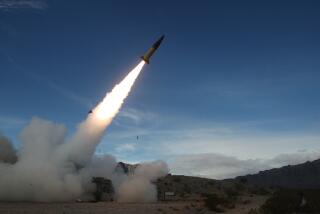Soviets Speed Laser Defenses, Pentagon Says
WASHINGTON — The Pentagon, pressing for international support for President Reagan’s “Star Wars” missile defense system, said Tuesday that the Soviets could be ready to deploy their own ground-based laser defense system within the next decade.
Using a worldwide television hookup to draw attention to the Kremlin’s military advances, Defense Secretary Caspar W. Weinberger said the Soviet laser development project, part of an anti-missile program, is “much larger than the United States’ effort.”
“Star Wars,” however, would rely on particle beams as well as lasers, which are light beams whose intense heat could “cook” the inside of an enemy missile.
Annual Evaluation
Weinberger’s presentation accompanied publication of the fourth edition of “Soviet Military Power,” a 143-page analysis of Soviet weaponry and military strategy that uses glossy photographs, drawings and charts to highlight Soviet abilities “to expand, modernize and deploy . . . increasingly capable weapons systems.”
Weinberger’s Pentagon news conference, beamed to reporters in Europe and the Far East through a two-way satellite telecast, came as Congress moved into the early stages of its annual review of Reagan’s defense budget, which is facing ever-greater scrutiny in light of the overall budget deficit.
In the last year, the defense secretary said, the Soviets moved closer to deploying two new intercontinental ballistic missiles--the 10-warhead SS-X-24 and the single-warhead SS-X-25.
He said two bases for the SS-X-25 are “nearing operational” status, “indicating a readiness to deploy (it) very soon.”
One defense intelligence analyst said that, “if the Russians wanted to, they could deploy it right now.”
The United States claims that the SS-X-25 violates the second strategic arms limitation treaty. The SALT II pact, which both nations have said they would follow although it has not been ratified by the U.S. Senate, limits each side to one new long-range missile. The United States says the SS-X-24 is that missile for the Soviets, but the Soviets maintain that the SS-X-24 is simply an updated version of a previously deployed missile.
In addition, the Soviets are working on two newer intercontinental ballistic missiles, including one that would be larger than the SS-X-24, Weinberger said.
According to the secretary, the Soviets also have launched a new class of submarine, dubbed the Akula. Although officials provided little information about it, the Pentagon said it is capable of carrying the land-attack cruise missile known as the SS-NX-21, which has a range of about 1,800 miles.
Weinberger said the Soviets have increased their deployment of Typhoon-class submarines, capable of carrying 20 SS-N-20 nuclear missiles. The approximate 5,000-mile range of the missiles, each carrying nine warheads, would allow the submarines to operate in protected waters close to Soviet territory and still hit targets in Europe and North America.
Referring to Soviet progress on a variety of weapons, including those for use by ground troops in conventional warfare, the defense intelligence analyst said: “We see great momentum across the board.”
As for work on anti-missile systems, Weinberger said the Soviets operate more than six “major research and development facilities and test ranges” dealing with laser weapons, with 10,000 scientists and engineers assigned to the program.
A year ago, the Pentagon said that the Soviets, by the late 1980s, could develop prototypes for ground-based lasers that would direct beams of intense energy against enemy ballistic missiles. It reiterated that estimate this year and added that components of a large-scale system could undergo tests in the early 1990s.
While operational deployment is not likely in this century, the Pentagon booklet said, “with high priority and some significant risk of failure, the Soviets could skip some testing steps and be ready to deploy a ground-based laser ballistic missile defense by the mid-1990s.”
The Pentagon also said that the Soviet Union is developing an airborne laser that, if successful, could be deployed in the early 1990s as a satellite killer.
Weinberger used the report to back up the Adminstration’s $3.7-billion research request for the proposed Strategic Defense Initiative, popularly known as “Star Wars.”
“All of this emphasizes . . . the very extensive work and resources the Soviets are devoting to the very defensive systems that they propose and say are so very dangerous if we pursue them,” he said. “They are not only doing it themselves; they clearly want a monopoly in this field.”
‘More Dangerous World’
He added:
“If the Soviets should get a kind of defensive system that we are doing research on now . . . you’d have a very much more dangerous world in which stability would not be one of the factors that you’d be permitted to talk about any longer.”
In Moscow, Tass, the Soviet news agency, said the report “is clearly a fantastic piece of fiction.”
Tass military analyst Vladimir Chernyshev, referring to the assessment of Soviet missile defenses, said U.S. officials “cannot have at their disposal any real facts that could confirm the truth of their inventions.”
U.S. officials did not divulge the sources of the information in the book, prepared by defense intelligence analysts.
More to Read
Sign up for Essential California
The most important California stories and recommendations in your inbox every morning.
You may occasionally receive promotional content from the Los Angeles Times.










